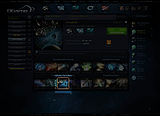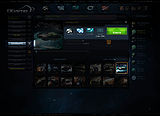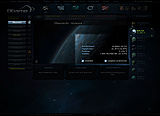Difference between revisions of "Tutorial:Colonisation"
Francolino (Talk | contribs) |
|||
| (13 intermediate revisions by 4 users not shown) | |||
| Line 1: | Line 1: | ||
{{PageHead-Tutorial}} | {{PageHead-Tutorial}} | ||
| + | |||
| + | At the beginning every player gets automatically assigned his home planet to construct his buildings there. But that does not suffice in the long run to keep up with other players – if you do not develop new planets, you will notice very fast, that you will stay behind the other players. Although the creation of new colonies is very costly at the beginning of the game, it gives a good return again. More planets mean more mines and more planets from which your fleets can go on raids, which means a bigger raid area. That is why it is important to research as fast as possible the astrophysics and the colony ships to expand your empire gradually. | ||
| + | |||
| + | ==How to colonise planets ?== | ||
| + | |||
| + | To colonise a new planet you need a colony ship – a special unit, which has only that function. However, to build it you need the impulse drive on level 3, and the building costs of 10.000 metal, 20.000 crystal and 10.000 deuterium are far from cheap. Anyhow it is profitable to save the accordant amount of resources early to build colony ships. To colonise a second planet the astrophysics must be on level 1, at least. For each further planet you have to research 2 extra levels of that technology. | ||
| + | |||
| + | As soon as the needed level of the astrophysics is done and a colony ship is available, you can look for a position in the galaxy view to colonise. It will only be possible, if there is no other player on this position, hence the line is empty and if the level of the astrophysics suffices for this position ( with level 1: 4 – 12, with level 4: 3 – 13, with level 6: 2 – 14, with level 8: 1 – 15). If you have found a place, you will have to elect a colony ship and to send it with the mission “colonise” to the accordant coordinates. Normally you have to be patient for a few hours, because the colony ship is anything but fast. | ||
| + | {{Screenshot|Colonisation|A}} | ||
| + | As soon as the ship achieves the approached coordinates, one of these three cases will happen, according to the given situation: | ||
| + | # The position could be colonised and your empire was expanded with one further planet. The colony ship disappears; instead the common resources for the start appear on the new colony. Resources, which have been picked up additionally by the colony ship, will also be credited there. | ||
| + | # Another player has already colonised the position you have had approached or a planet has been abandoned there quite recently. Your colony ship adjourns home again and is soon ready for a new try. | ||
| + | # You do not have the needed level of the astrophysics, the colony ship returns in vain. | ||
| + | |||
| + | {{Infobox-Reward | ||
| + | |As soon as you have established your first colony successfully, you get access to all features of the commander for three days for free.}} | ||
| + | |||
| + | ==What do I have to bear in mind ?== | ||
| + | |||
| + | Every new planet costs a colony ship, at the beginning of the game that is first and foremost none too sparse. That is why you should maintain every planet as a start at that time and build mines to boost the own economy. But in the further progress the size of the planets will be more and more important, because more and more mines and other buildings have to be constructed. After a reasonable time you should break away from the too small colonies and replace those by bigger ones – most of the players define 200 fields as minimum level. Henceforward, every new colonised planet, which does not meet your requirements, should be abandoned immediately – indeed so you lose resources, but the damage, which will be done by a too small planet is much bigger. After destroying a planet, an asteroid field occurs at that place, which stays there for 24 till 48 hours and bans that position for colony ships – not till than you can send a new ship there and try your luck again. The deletion of asteroid fields always takes place at 1:20 am. | ||
| + | |||
| + | ==Which position shall I colonise ?== | ||
| + | |||
| + | The size of the planet will be defined not until with the colonization and it is very random. So you cannot know in advance, if the planet of your dreams with more than sufficient fields occurs this time, or just a useless boulder again. However you can control it with the choice of the position. The more the planet is at the outer edge of the solar system, the lower is the chance to get a useable planet there. In contrast the central positions 7, 8 and 9 often produce useable colonies. | ||
| + | |||
| + | But there is another reason why the position of the planet is important: try to imagine that the fixed star of the solar systems in OGame is on position 0, while disregarding the distance. The more above in the galaxy view, the closer the planet is at the sun. The outcome of this is a difference in temperature. Because of that, two important attributes for a decision are the result: the energy production of the solar satellites and the production of the deuterium synthesizer. The closer the planet is at the sun, the more efficient the solar satellites can work, and that is of particular importance to achieve the necessary energy for the graviton technology. But also miners or other players, who count on that energy source, will have problems with a halved production. To balance those cons: the colder the planets, the more the deuterium production is boosted – why planets, which are more down, are suited better for the production of that worthwhile resource. | ||
| + | |||
| + | {{Screenshot|Colonisation|B}} | ||
| + | |||
| + | ==Colony sizes and temperatures== | ||
| + | |||
| + | Below is an empirical investigation into colony sizes and temperatures. The given temperature is always the second number shown on the ingame overview screen; for example if you had "Temperature 7°C to 47°C", 47°C would be used. | ||
{{Overview-PlanetParameter}} | {{Overview-PlanetParameter}} | ||
{{PageFoot-Tutorial}} | {{PageFoot-Tutorial}} | ||
Latest revision as of 03:21, 5 January 2012
At the beginning every player gets automatically assigned his home planet to construct his buildings there. But that does not suffice in the long run to keep up with other players – if you do not develop new planets, you will notice very fast, that you will stay behind the other players. Although the creation of new colonies is very costly at the beginning of the game, it gives a good return again. More planets mean more mines and more planets from which your fleets can go on raids, which means a bigger raid area. That is why it is important to research as fast as possible the astrophysics and the colony ships to expand your empire gradually.
How to colonise planets ?
To colonise a new planet you need a colony ship – a special unit, which has only that function. However, to build it you need the impulse drive on level 3, and the building costs of 10.000 metal, 20.000 crystal and 10.000 deuterium are far from cheap. Anyhow it is profitable to save the accordant amount of resources early to build colony ships. To colonise a second planet the astrophysics must be on level 1, at least. For each further planet you have to research 2 extra levels of that technology.
As soon as the needed level of the astrophysics is done and a colony ship is available, you can look for a position in the galaxy view to colonise. It will only be possible, if there is no other player on this position, hence the line is empty and if the level of the astrophysics suffices for this position ( with level 1: 4 – 12, with level 4: 3 – 13, with level 6: 2 – 14, with level 8: 1 – 15). If you have found a place, you will have to elect a colony ship and to send it with the mission “colonise” to the accordant coordinates. Normally you have to be patient for a few hours, because the colony ship is anything but fast.
As soon as the ship achieves the approached coordinates, one of these three cases will happen, according to the given situation:
- The position could be colonised and your empire was expanded with one further planet. The colony ship disappears; instead the common resources for the start appear on the new colony. Resources, which have been picked up additionally by the colony ship, will also be credited there.
- Another player has already colonised the position you have had approached or a planet has been abandoned there quite recently. Your colony ship adjourns home again and is soon ready for a new try.
- You do not have the needed level of the astrophysics, the colony ship returns in vain.
What do I have to bear in mind ?
Every new planet costs a colony ship, at the beginning of the game that is first and foremost none too sparse. That is why you should maintain every planet as a start at that time and build mines to boost the own economy. But in the further progress the size of the planets will be more and more important, because more and more mines and other buildings have to be constructed. After a reasonable time you should break away from the too small colonies and replace those by bigger ones – most of the players define 200 fields as minimum level. Henceforward, every new colonised planet, which does not meet your requirements, should be abandoned immediately – indeed so you lose resources, but the damage, which will be done by a too small planet is much bigger. After destroying a planet, an asteroid field occurs at that place, which stays there for 24 till 48 hours and bans that position for colony ships – not till than you can send a new ship there and try your luck again. The deletion of asteroid fields always takes place at 1:20 am.
Which position shall I colonise ?
The size of the planet will be defined not until with the colonization and it is very random. So you cannot know in advance, if the planet of your dreams with more than sufficient fields occurs this time, or just a useless boulder again. However you can control it with the choice of the position. The more the planet is at the outer edge of the solar system, the lower is the chance to get a useable planet there. In contrast the central positions 7, 8 and 9 often produce useable colonies.
But there is another reason why the position of the planet is important: try to imagine that the fixed star of the solar systems in OGame is on position 0, while disregarding the distance. The more above in the galaxy view, the closer the planet is at the sun. The outcome of this is a difference in temperature. Because of that, two important attributes for a decision are the result: the energy production of the solar satellites and the production of the deuterium synthesizer. The closer the planet is at the sun, the more efficient the solar satellites can work, and that is of particular importance to achieve the necessary energy for the graviton technology. But also miners or other players, who count on that energy source, will have problems with a halved production. To balance those cons: the colder the planets, the more the deuterium production is boosted – why planets, which are more down, are suited better for the production of that worthwhile resource.
Colony sizes and temperatures
Below is an empirical investigation into colony sizes and temperatures. The given temperature is always the second number shown on the ingame overview screen; for example if you had "Temperature 7°C to 47°C", 47°C would be used.
| Position | Planet temperature | Satellite energy | Deut. level 10 | Deut. level 30 | Fields | ||||||||||||
|---|---|---|---|---|---|---|---|---|---|---|---|---|---|---|---|---|---|
| minimum | ø | maximum | minimum | maximum | minimum | maximum | minimum | maximum | minimum | ø | maximum | ||||||
| 1 | 220°C | 240°C | 260°C | 60 | 66 | 103 | 145 | 2.093 | 2.931 | 95 | 100 | 108 | |||||
| 2 | 170°C | 190°C | 210°C | 51 | 58 | 155 | 197 | 3.140 | 3.978 | 97 | 103 | 110 | |||||
| 3 | 120°C | 140°C | 160°C | 43 | 50 | 207 | 248 | 4.187 | 5.025 | 98 | 118 | 137 | |||||
| 4 | 70°C | 90°C | 110°C | 35 | 41 | 259 | 300 | 5.234 | 6.072 | 123 | 164 | 203 | |||||
| 5 | 60°C | 80°C | 100°C | 33 | 40 | 269 | 311 | 5.444 | 6.281 | 148 | 179 | 213 | |||||
| 6 | 50°C | 70°C | 90°C | 31 | 38 | 280 | 321 | 5.653 | 6.491 | 148 | 194 | 227 | |||||
| 7 | 40°C | 60°C | 80°C | 30 | 36 | 290 | 331 | 5.862 | 6.700 | 141 | 193 | 238 | |||||
| 8 | 30°C | 50°C | 70°C | 28 | 35 | 300 | 341 | 6.072 | 6.909 | 163 | 208 | 247 | |||||
| 9 | 20°C | 40°C | 60°C | 26 | 33 | 311 | 352 | 6.281 | 7.119 | 155 | 197 | 238 | |||||
| 10 | 10°C | 30°C | 50°C | 25 | 31 | 321 | 363 | 6.491 | 7.328 | 154 | 188 | 223 | |||||
| 11 | 00°C | 20°C | 40°C | 23 | 30 | 331 | 373 | 6.700 | 7.538 | 146 | 176 | 204 | |||||
| 12 | -10°C | 10°C | 30°C | 21 | 28 | 342 | 383 | 6.909 | 7.747 | 136 | 154 | 171 | |||||
| 13 | -50°C | -30°C | -10°C | 15 | 21 | 383 | 425 | 7.747 | 8.585 | 109 | 115 | 121 | |||||
| 14 | -90°C | -70°C | -50°C | 8 | 15 | 425 | 466 | 8.585 | 9.422 | 81 | 86 | 93 | |||||
| 15 | -130°C | -110°C | -90°C | 1 | 8 | 466 | 508 | 9.422 | 10.260 | 65 | 69 | 74 | |||||





